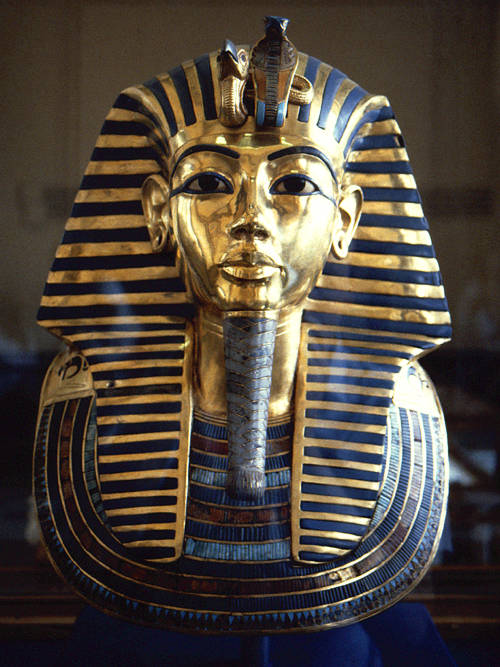| Revision as of 08:15, 26 February 2004 view sourceMav (talk | contribs)Extended confirmed users77,874 editsm image fm← Previous edit | Revision as of 04:32, 30 March 2004 view source Llywrch (talk | contribs)Autopatrolled, Administrators81,186 edits mostly linksNext edit → | ||
| Line 1: | Line 1: | ||
| ] ] ] ] ] | ] ] ] ] ] | ||
| '''Tutankhamun''' or '''Tutankhaten''' was ] of |
'''Tutankhamun''' or '''Tutankhaten''' was ] of the ] (]/] - ]), during the period known as the ]. His original name Tutankhaten means "Living Image of ]" while Tutankhamun means "Living Image of ]. | ||
| ] | ] | ||
Revision as of 04:32, 30 March 2004
Tutankhamun or Tutankhaten was Pharaoh of the Eighteenth dynasty of Egypt (1334 BC/1333 BC - 1323 BC), during the period known as the New Kingdom. His original name Tutankhaten means "Living Image of Aten" while Tutankhamun means "Living Image of Ammon.

Tutankhamun (or "King Tut") is perhaps best known to modern westerners as the only pharaoh to have his nearly intact tomb (KV62) discovered. (The wealth of objects discovered in this young king's tomb naturally leads to speculation on what might have been contained in the plundered tombs of far more significant Pharaohs.) However, he is historically important as well.
Tutankamun's parentage is uncertain. An inscription calls him a king's son, but it is debated which king was meant. Most scholars consider that he was probably a son either of Amenhotep III (though probably not by his Great Royal Wife Tiye), or of Amenhotep III's son Amenhotep IV (also known as Akhenaton), perhaps with his enigmatic second queen, Kiya. It should be noted though that when Tutankhaten succeeded Akhenaton to the throne, Amenhotep III was already dead for seventeen years. Tutankhamun ruled Egypt for eight to ten years and examinations of his mummy suggest that he was a seventeen or eighteen year old man when he died. This would place his birth around 1341 BC/ 1340 BC and would make it unlikely that Amenhotep III was his father.
Tutankhamun was married to Ankhesenpaaten, a daughter of Akhenaton, and he was responsible for reversing much of his father-in-law's Amarna revolution, in which Akhenaton attempted to supplant the existing priesthood and gods with a god who was until then considered minor, Aten.
In year 3 of his reign (1331 BC), Tutankhamun, who was still a young boy and probably under the influence of two older advisors, restored the old pantheon of gods and their temples, granted the traditional privileges back to their priesthoods, and moved the capital back to Thebes.
Tutankhamun died at the age of 18 of unknown causes. On his mummy there is evidence of an injury to his head, which apparently had time to partially heal before his death. The injury could be the result of an accident but it has also been suggested that the young Pharaoh was murdered.
Tutankhamun was briefly succeeded by the elder of his two advisors, Ay, and then by the other, Horemheb, who obliterated most of the evidence of the rules of Akhenaton, Tutankhamun, and Ay.
Tutankhamun existence is believed to have been forgotten shortly after his death and until the 20th century. It has been suggested that his tomb was never opened by either grave robbers or priests exactly because of its forgotten status.
Howard Carter (paid by Lord Carnarvon) discovered Tutankhamun's tomb on November 4, 1922 near the entrance to the tomb of Ramses VI, setting off a renewed interest in the modern world in all things Egyptian. Carter contacted his patron and on November 26 that year both men became the first people to enter Tutankhamun's tomb in over 3000 years. After many weeks of careful excavation, on February 16, 1923 Carter opened the burial chamber and first saw the sarcophagus of Tutankhamun.
For many years, rumors of a "curse" (probably fueled by newspapers at the time of the discovery) persisted, emphasizing the early death of some of those who had first entered the tomb. However, a recent study of journals and death records indicates no statistical difference between the age of death of those who entered the tomb and those on the expedition who did not. Indeed, most lived to past 70.
External links
- Tutankhamun : Pictures
- End Paper: A New Take on Tut's Parents by Dennis Forbes (KMT 8:3 . FALL . 1997 � KMT Communications)
- The mummy's curse: historical cohort study (Mark R Nelson, British Medical Journal 2002;325:1482-1484)
- A more detailed profile of him
Further reading
- The Discovery of the Tomb of Tutankhamen, by Howard Carter, Arthur C. Mace.
- The Complete Tutankhamun: The King, the Tomb, the Royal Treasure, by C. N. Reeves, Nicholas Reeves, Richard H. Wilkinson
- The Murder of Tutankhamen: A True Story, by Bob Brier